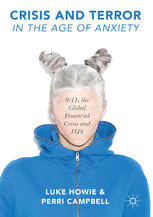
Crisis and Terror in the Age of Anxiety: 9/11, the Global Financial Crisis and ISIS PDF
Preview Crisis and Terror in the Age of Anxiety: 9/11, the Global Financial Crisis and ISIS
Crisis and Terror in the Age of Anxiety Luke Howie (cid:129) Perri Campbell Crisis and Terror in the Age of Anxiety 9/11, the Global Financial Crisis and ISIS LukeHowie PerriCampbell SchoolofSocialSciences CollegeofDesignandSocialContext MonashUniversity RMITUniversity Melbourne,Victoria,Australia Melbourne,Victoria,Australia ISBN978-1-137-51628-2 ISBN978-1-137-51629-9(eBook) DOI10.1057/978-1-137-51629-9 LibraryofCongressControlNumber:2016963102 ©TheEditor(s)(ifapplicable)andTheAuthor(s)2017 Theauthor(s)has/haveassertedtheirright(s)tobeidentifiedastheauthor(s)ofthisworkinaccordance withtheCopyright,DesignsandPatentsAct1988. Thisworkissubjecttocopyright.AllrightsaresolelyandexclusivelylicensedbythePublisher,whether thewholeorpartofthematerialisconcerned,specificallytherightsoftranslation,reprinting,reuseof illustrations, recitation, broadcasting, reproduction on microfilms or in any other physical way, and transmission or information storage and retrieval, electronic adaptation, computer software, or by similarordissimilarmethodologynowknownorhereafterdeveloped. Theuseofgeneraldescriptivenames,registerednames,trademarks,servicemarks,etc.inthispublication doesnotimply,evenintheabsenceofaspecificstatement,thatsuchnamesareexemptfromtherelevant protectivelawsandregulationsandthereforefreeforgeneraluse. Thepublisher,theauthorsandtheeditorsaresafetoassumethattheadviceandinformationinthis book are believed to be true and accurate at the date of publication. Neither the publisher nor the authorsortheeditorsgiveawarranty,expressorimplied,withrespecttothematerialcontainedherein orforanyerrorsoromissionsthatmayhavebeenmade.Thepublisherremainsneutralwithregardto jurisdictionalclaimsinpublishedmapsandinstitutionalaffiliations. Coverillustration©AliakseiKaponia/AlamyStockPhoto Printedonacid-freepaper ThisPalgraveMacmillanimprintispublishedbySpringerNature TheregisteredcompanyisMacmillanPublishersLtd. Theregisteredcompanyaddressis:TheCampus,4CrinanStreet,London,N19XW,UnitedKingdom Acknowledgements This book, and the research within it, are a product of a long journey involving research into the impact of 9/11 on people in diverse parts of the world that included places like Melbourne, Geelong, Sydney, Los Angeles, Auckland, Mosul, Baghdad and Kabul. Soon we were witnessing similar consequences emerging as a result of other threats and risks such as the simultaneously ubiquitous yet hidden Global FinancialCrisis(GFCorsub-primemortgagecrisisortheforeclosure crisis) and the supposed threat posed by criminals, people from ff di erent religions, bullies, social networking websites, tainted food, to name a small few. What they had in common was an exaggerated, often incredible, human, decision-making based, response. That response can be broadly called anxiety. Anxiety itself is then, in ff turn, made subject to further anxieties which include the e ects of stress on the body, on the mind, and on our abilities to maintain relationships, employment, and well-being in an increasingly com- plex, and doubtful, 21st century. People we learn, when one spends time with them, are anxiety seeking machines. Anxiety, you see is – bothdevastatingandprotecting anxietymakesusfeelbad,butifwe ’ concentrate on our anxiety then we can avoid confronting anxiety s cause, impetus, or its hard, resistant, kernel. This book is our modest attempt at confronting some of these things. We do not necessarily feel better for having done so. v vi Acknowledgements fi – Assuch,our rstacknowledgementsaretothosepeople manyofthem – young, disadvantaged to some degree, often marginalised who were the respondentsinourresearch.Youareforeverwithus,andwehopewehave donejusticetoyourwordsasweunderwentprocessesofturningtheminto our words to write this book. The stories we heard are both haunting and full of hope. They promise a future of rage but also love. Our research would not have been possible without a host of colleagues that have assisted us throughout. The following people ff have o ered feedback and advice at many stages in the research and writing process: Peter Kelly, Chris Hickey, Christine Trost, Lynn ’ Harrison, Kerry OBrien, Pete Lentini, Craig Hollis, Lucas Walsh, Ros Black and Ben Wellings. We also want to thank our colleagues in the School of Education at Deakin University, School of Social Sciences at Monash University with special acknowledgement of the Politics and International Relations department, and the Institute for theStudyofSocietalIssuesattheUniversityofCalifornia atBerkeley. Our thanks also go to our undergraduate and postgraduate students, fi with whom ongoing debates on these and related matters signi cantly aided our ability to crystalize many of the phenomena we explore in these pages. In particular, students in the Politics of Identity course at ff Monash University o ered deep insights into possible anxious eco- nomic futures. Ourthankstofriendsandfamilythathaveputupwithusthroughoutthe process of researching, writing and travelling in Australia and the United Stateswherewevisitedsomediverselocationsforourresearchthatincluded Los Angeles, San Francisco, Oakland, Berkeley, Orange County, Boston, Manhattan, Lincoln and Omaha. Our thanks to Margaret and Craig Campbell,HamishCampbell,Chantelle,KentandOllieHodgson,Maree Luckman, Maddi Howie, Elle Howie, Margaret Luckman, Lawrence and Kathryn Obaldo, Kaine and Jaci Leonard, Chris Henderson, Sarah Craig, Shan Hyder and Kerri Coomber, Nick Hyder, Apollo, Christine Trost, PeterKellyandChrisHickey.Ourthanksalsotothededicatededitorsand employeesatPalgraveMacmillan. Thefollowingchaptersarerevisedversionsofarticlespublishedelsewhere, andtheyareusedherewithpermission.Chapterfouroriginallyappearedas ‘ ’ ’ GuerrillaSelfhood:ImaginingYoungPeoplesEntrepreneurialFutures,in Acknowledgements vii – theJournalofYouthStudies,volume19,issue7,pp.906 920.Partofchapter ‘“ sixoriginallyappearedas WearaNecklaceofH(R)opeSidebySidewith ” ’ me : Young Peoples Neo-Liberal Futures and Popular Culture as Political ’ Action, in the collection of essays edited by Peter Kelly and Jo Pike titled ’ Neo-LiberalismandAusterity:TheMoralEconomiesofYoungPeoplesHealth – and Well-Being (2017, Palgrave Macmillan, pp. 53 68). Chapter eight ‘ originally appeared as Security Guards and Counter-terrorism: Tourism ’ andGapsinTerrorismPrevention,intheInternationalJournalofReligious – Tourism and Pilgrimage, volume 1, issue 2, pp. 38 47, available in open accessatArrow@DIT(arrow.dit.ie). Contents 1 Imagining a Future of Crisis, Terror and Anxiety 1 2 Anxiety, Violence and the Social World 23 3 Precarious Futures: Young People and the Global Financial Crisis 47 4 Guerrilla Selfhood: Imagining Entrepreneurial Futures 73 5 Responsiveness and Re-imagining the Future with Occupy and Black Lives Matter 95 6 The Global Financial Crisis in Pop-Culture 123 ’ 7 Iraqi Womens Stories of Anxiety and Unrest from the Blogosphere 153 8 Security Guards and Counter-terrorism: Gaps in Terrorism Prevention 177 9 The Politics of Anxiety 193 ix x Contents References 211 Index 239 1 Imagining a Future of Crisis, Terror and Anxiety ‘ ’ ff The world needs tranquillity, was the advice o ered by Nathan Kline, fi theresearchdirectorofRocklandStateHospitalandseminal gureinthe history of psychopharmacology. At a Manhattan dinner attended by fi ’ Kline and fellow seminal gure Frank Berger the course of the worlds – relationshipwithanxietywasaltered(Stossel2014:161 162).Bergerwas – the creator of the psychoactive drug meprobamate better known as fi Miltown. Miltown was the rst mass-marketed psychiatric drug (Herzberg 2009). Its arrival to the pharmaceutical marketplace was initiallymetwithlittleinterest.Inthemonthsfollowingitsintroduction in May 1955, its manufacturer Carter Products only sold about $7500 worthpermonth.InDecember1955Americansbought$500,000worth ‘ ’ of Miltown and soon they were buying tens of millions worth of Miltown a year (Stossel 2014: 162). As a measure of its popularity, its – use began to saturate popular culture as the use of psychoactive drugs saturates our culture today. It was even praised by Aldous Huxley; the grandfather of our fears of a drug-addled, hellish, dystopian future. It seemedtobethecure.Thiswasthebirthofantianxietymedication,and ‘ ’ ’ foratimethereseemedtobeasolutionto todayspressureliving anda perilous 1950s world that provided daily reminders of danger and © The Author(s) 2017 1 L. Howie, P. Campbell, Crisis and Terror in the Age of Anxiety, DOI 10.1057/978-1-137-51629-9_1
